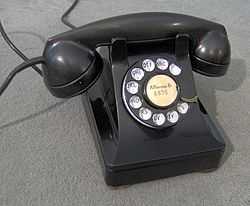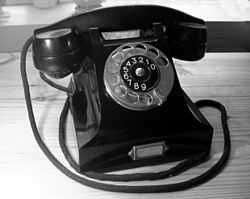Model 302 telephone

The Model 302 telephone is a desk set telephone that was manufactured in the United States by Western Electric from 1936 until production of entirely new units ceased about 1954, after the introduction of the modern model 500 telephone in 1949. However, units were routinely refurbished at least until 1958. After manufacturing ended, a modified version, the 5302 was issued until the mid-1960s through the Bell System refurbishing shops with a new modern housing that resembled the model 500.
The model 302 is a member of the 300-series telephones and was developed by the industrial design firm of Henry Dreyfuss. It was the first widely used American telephone to include the ringer and network circuitry in the same telephone housing.
Design and production
Designed by the firm of Henry Dreyfuss, the Model 302 included design elements influenced by Ericsson model DBH 1001 of 1931, designed in 1929 by the Norwegian artist and designer Jean Heiberg. After field trials in early 1936, large-scale deployment commenced and the model was never completely retired from service in the Bell System.

The model 302 was the first Western Electric telephone to include the ringer and network circuitry in the same desktop unit. Earlier Western Electric models (102, 202) required the use of an external subscriber set (subset) or ringer box, typically mounted on a wall.
The model 302 is built upon a rectangular steel base plate on which were mounted the ringer unit, the inductor coil, a metal can containing two capacitors, and a connector terminal plate. The base was supported by four leather-covered triangular feet attached under each corner of base. The housing sat on top of the base, secured with screws, and contained the rotary dial and the switchhook, which was activated by two plungers in the phone cradle.
The Model 302's housing was originally made out of cast zinc alloy, and these zinc shells continued to be manufactured into 1946. In 1941, as metal was increasingly scarce because of the ongoing war, metal was substituted with thermoplastic Tenite. The Tenite plastic housings were made into 1954, with later manufacture of shells being for the purpose of remanufacturing old sets.
Most of the Model 302 sets were issued in black. Later, plastic sets were also available in five colors (ivory, peking red, gray green, dark blue, old rose). Sets with painted metal housings were available in several colors. Metallic hues (dark gold, statuary bronze, old brass, oxidized silver) were available by special order.
The early phones had metal finger wheels, while later specimens, including all colored Tenite units, featured clear plastic finger wheels. Dial plates were made from steel with white vitreous enamel coating on U.S. WE 302 models, while European versions tended to use black Bakelite with white numbers.
The early units used the E1 handset, had a vent under the cradle, and had feet riveted to their bases. Beginning in 1938, the F1 handset was used, the vent was eliminated, the feet were screwed to the bases, and the cradle flanges and plungers were enlarged. The original handset cord was straight and covered with brown woven fabric, but a straight rubber-covered cord was later introduced, followed by a coiled rubber-covered cord.
The WE 302 was a rugged and easily repaired desk telephone. Most U.S. telephones were owned by The Bell System, and were provided to the subscriber as part of the monthly service fee. Some were sold, and can be identified by the handset numbering F1W, where the W signified a unit without Bell System markings. Beginning in August 1955 and extending into the 1960s, the Bell System remanufactured the 302 as the model 5302, with a newly designed housing, and sometimes with a handset of new design, which gave the set a similar appearance as the Model 500.
In addition to the model 302, the Western Electric 300-series included many variations and special purpose models with additional features. Conversion kits using a 302 housing and F1 handset to replace older manual candlestick telephones with an external subset were known as the AA1 and AB1 mounting.
After phase-out in the US, the Model 302's exterior design was retained by European Bell branch companies for such models as the 1954 Bell Standard, widely used in the Netherlands and Belgium.
Similar phones by other manufacturers

Other manufacturers produced sets of very similar appearance. Among the more notable of these were the Stromberg-Carlson Model 1243 telephone, distinguished by beveled corners and flanging on the handset, and the Federal Telephone & Radio model 803 (pictured) which featured components made by Automatic Electric.
In Popular Culture
The WE 302 appeared in many films from the time of its introduction through the 1960s, and was ubiquitous in television shows of its time, such as the popular 1950s situation comedy I Love Lucy. Thus, it is sometimes called the Lucy phone by modern collectors as a memorable way to refer to the model. [1]
See also
References
- ↑ "On the trail of the “Lucy Phone”". Dennis Markham's Classic Rotary Phones. 19 March 2008. Retrieved 27 May 2014.
External links
| ||||||||||||||||||||||||||